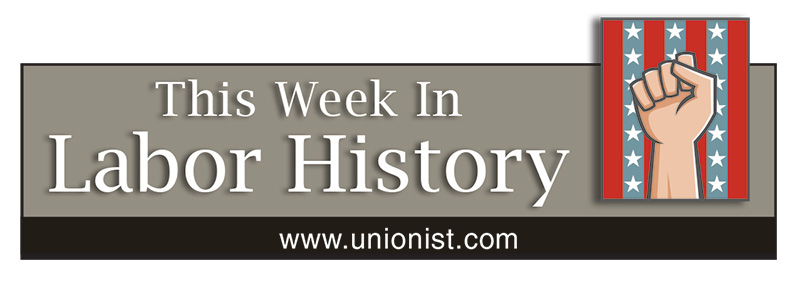
MARCH 2
1913 – Postal workers granted eight-hour day.
1990 – More than 6,000 drivers strike Greyhound Lines, most lose their jobs to strikebreakers after company declares “impasse” in negotiations.
MARCH 3
1906 – The local lumber workers’ union in Humboldt County, Calif., founds the Union Labor Hospital Association to establish a hospital for union workers in the county. The hospital became an important community facility that was financed and run by the local Labor Movement.
1915 – Congress approves the Seamen’s Act, providing the merchant marine with rights similar to those gained by factory workers. Action on the law was prompted by the sinking of the Titanic three years earlier. Among other gains: working hours were limited to 56 per week and guaranteed minimum standards of cleanliness and safety were put in place.
1931 – The Davis-Bacon Act takes effect. It orders contractors on federally financed or assisted construction projects to pay wage rates equal to those prevailing in local construction trades.
MARCH 4
1913 – President William Howard Taft signs legislation creating the Department of Labor. Former United Mine Workers Secretary Treasurer William B. Wilson is named to lead the new department.
1933 – President Franklin D. Roosevelt names a woman, Frances Perkins, to be Secretary of Labor. Perkins became the first female cabinet member in U.S. history.
1989 – Machinists strike Eastern Airlines, are soon joined by flight attendants and pilots in the nationwide walkout. Owner Frank Lorenzo refuses to consider the unions’ demands; Eastern ultimately went out of business.
MARCH 5
1770 – British soldiers, quartered in the homes of colonists, took the jobs of working people when jobs were scarce. On this date, grievances of rope makers against the soldiers lead to a fight. Soldiers shot down Crispus Attucks, a black colonist, then others, in what became known as the Boston Massacre. Attucks is considered the first casualty in the American Revolution.
MARCH 6
1885 – The Sailors’ Union of the Pacific, a union of mariners, fishermen and boatmen working aboard U.S. flag vessels, is founded in San Francisco.
1886 – The Knights of Labor picket to protest the practices of the Southwestern Railroad system, and the company’s chief, high-flying Wall Street financier Jay Gould. Some 9,000 workers walked off the job, halting service on 5,000 miles of track. The workers held out for two months, many suffering from hunger, before they finally returned to work.
1913 – Joe Hill’s song “There is Power in a Union” appears in Little Red Song Book, published by the Wobblies.
1930 – With the Great Depression under way, hundreds of thousands of unemployed workers demonstrate in some 30 cities and towns; close to 100,000 filled Union Square in New York City and were attacked by mounted police.
1970 – The federal Coal Mine Health and Safety Act is enacted.
1972 – Predominantly young workers at a Lordstown, Ohio, GM assembly plant stage a wildcat strike, largely in objection to the grueling work pace. At 101.6 cars per hour, their assembly line was believed to be the fastest in the world.
1978 – President Jimmy Carter invokes the Taft-Hartley law to halt the 1977-78 national contract strike by the United Mine Workers of America. The order was ignored, and Carter did little to enforce it. A settlement was reached in late March.
2009 – The U.S. Department of Labor reports that the nation’s unemployment rate soared to 8.1 percent in February, the highest since late 1983, as cost-cutting employers slashed 651,000 jobs amid a deepening recession.
MARCH 7
1860 – Some 6,000 shoemakers, joined by about 20,000 other workers, strike in Lynn, Mass. They won raises, but not recognition of their union.
1932 – Three thousand unemployed auto workers, led by the Communist Party of America, brave the cold in Dearborn, Mich., to demand jobs and relief from Henry Ford. The marchers got too close to the gate and were gassed. After re-grouping, they were sprayed with water and shot at. Four men died and 60 were wounded.
1937 – Steel Workers Organizing Committee — soon to become the United Steel Workers — signs its first-ever contract, with Carnegie-Illinois, for $5 a day in wages, benefits.
1942 – IWW founder and Labor organizer Lucy Parsons dies.
1988 – Hollywood writers represented by the Writers Guild of America strike against 200 television and movie studios over residuals payments and creative rights. The successful strike lasted 150 days, one of the longest in industry history.
2003 – Musicians strike Broadway musicals and shows go dark when actors and stagehands honor picket lines. The strike was resolved after four days.
MARCH 8
1924 – Three explosions at a Utah Fuel Co. mine in Castle Gate, Utah, kill 171. Fifty of the fatalities were native-born Greeks, 25 were Italians, 32 English or Scots, 12 Welsh, four Japanese, and three Austrians (or South Slavs). The youngest victim was 15; the oldest, 73.
1926 – New York members of the Fur and Leather Workers Union, many of them women, strike for better pay and conditions. They persevere despite beatings by police, winning a 10 percent wage increase and five-day work week.
1932 – The Norris-LaGuardia Anti-Injunction Act takes effect. It limits the ability of federal judges to issue injunctions against workers and unions involved in labor disputes.
1979 – César Chávez leads 5,000 striking farmworkers on a march through the streets of Salinas, Calif.
(Compiled by David Prosten, founder Union Communication Services)

